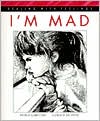Emotions described in acrostic poems

Wrote poems about mad, sad, glad, scared, and ashamed
Tried this poem-writing activity with a 14-year-old boy who struggles to identify and articulate him emotions. The result was five poems written about mad, sad, glad, scared, and ashamed. Several things happened before writing the poems to help him become familiar with feelings and the bodily sensations that go along with emotions. We discussed emotions and the different ways they can impact your body: tense, tight, tears, tingly, hot, cold, etc. Then we read several children’s books about emotions. His last exercise before writing the poems was to draw stick people to depict mad, sad, glad, scared, and ashamed, with the most important aspect the facial expression.
The poetry exercise began with showing him an acrostic poem where each letter of a person’s name or a word become the first letter of a line of poetry. For example, tree, might become a poem like this:
Tree
They are big or sometimes small
Reaching always for the sky
Every kind grows in the park
Each one has leaves, a trunk, and roots.
The boy wrote one acrostic poem using his name to describe himself, then another poem using the word “rain.” Next, I asked him to write one poem for each of the main emotion words we had discussed and that he had drawn pictures of. The result was close to astonishing! This boy who, a short time ago, described everything as being either sad or happy, and when asked how emotions felt in his body said, “Can’t feel anything,” could now distinguish nuances of emotions! When I asked him what he thought about his poems, he said, “I feel very proud!” And, he should!
Here are two examples of what he wrote:
Glad
Gives you energy
Let’s you laugh
Always makes you smile
Does not make you feel lonely.
Scared
Sometimes can make you cry
Can make you nervous
And make you tense
Reminds you of scary thoughts about it
Even can make you shake
Does not make you feel relaxed.
The process of having to think about different ways to describe an emotion helps embed it in the child’s brain. The more opportunities we give a child to articulate and talk about his or her emotions, the less potential their is for acting out those emotions inappropriately.

 Nothing, by Mick Inkpen, tells the story of a sad, lonely, misshapen stuffed cat. He’s left behind in an attic when the family moves out. He can’t quite remember who he is or what his name is. One of the movers shines a flashlight on him and says, “Oh, it’s nothing,” so he decides his name must be Nothing. He meets up with a mouse, a fox, and a frog, and eventually a tabby cat. Nothing cries to the cat, “I don’t know who I am!” The tabby cat befriends Nothing and takes him on an adventure. Eventually, the tabby cat takes Nothing home. Nothing finds out that he, in fact, belongs to this family. They clean him up, fix his injuries, and envelop him in love. He has a family! He’s home! He’s loved!
Nothing, by Mick Inkpen, tells the story of a sad, lonely, misshapen stuffed cat. He’s left behind in an attic when the family moves out. He can’t quite remember who he is or what his name is. One of the movers shines a flashlight on him and says, “Oh, it’s nothing,” so he decides his name must be Nothing. He meets up with a mouse, a fox, and a frog, and eventually a tabby cat. Nothing cries to the cat, “I don’t know who I am!” The tabby cat befriends Nothing and takes him on an adventure. Eventually, the tabby cat takes Nothing home. Nothing finds out that he, in fact, belongs to this family. They clean him up, fix his injuries, and envelop him in love. He has a family! He’s home! He’s loved!
